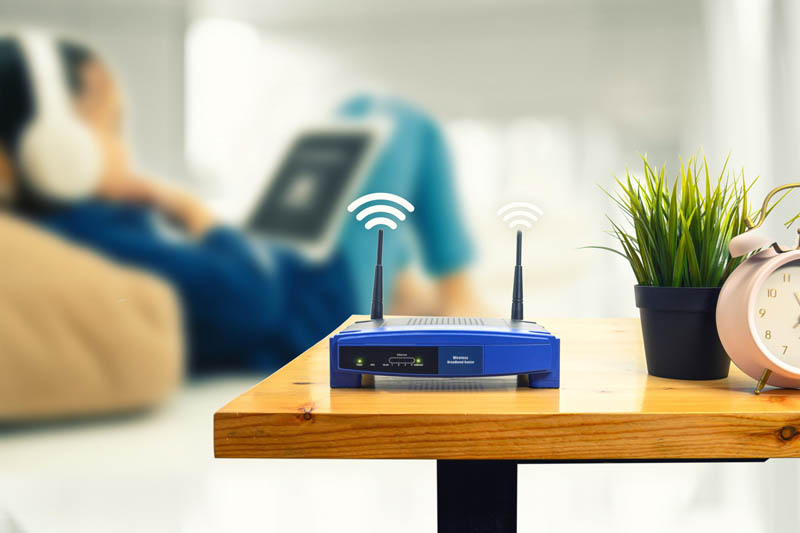Wi-Fi signals are valuable. When you move away from the router, your Wi-Fi signal will weaken. If you go far enough, you will reach a place where Wi-Fi doesn’t work. In that case, you might be wondering how to make your Wi-Fi signal stronger.
Upgrade your router to the 802.11ac or 802.11ax standard.
One of the easiest ways to boost your Wi-Fi signal is to get a new router. If you still have an old 802.11g or 802.11n router, your Wi-Fi won’t work as well as it could. Older routers that use older Wi-Fi standards don’t have the same power or speed as newer routers that use the latest 802.11ac Wi-Fi standard. The speed at which information is transmitted over the same distance may be the biggest difference between old standards and the newer 802.11ac standard.
For example, 802.11n came out in 2009 and can send around 600Mbps (around 75MB/s) over a maximum distance of 300 feet outside and about 150 feet inside. 802.11ac, which came out in 2014, can send around 1.13Gbps (about 166.25MB/s) over the same distance.
You can improve your Wi-Fi signal by moving your router.
If you put your Wi-Fi router under the stairs, it won’t work as well. Or behind a piece of steel wrapped in aluminum foil or a cabinet. When thinking about how to extend your Wi-Fi range, where you put your router is important. Putting your router behind a big, solid object will reduce the range of your Wi-Fi.
Most of the time, a hallway in the middle of your house is the best place so the Wi-Fi signal can reach everyone. That doesn’t always work. Move your router to where it won’t be blocked by too much stuff, big objects, or other things. If you require to move your router from where it is now, you might want to think about getting longer cables.
Switch to Wireless Mesh to increase Wi-Fi coverage
A wireless mesh network is a great way to ensure that your home gets the same Wi-Fi signal everywhere. Mesh Wi-Fi usually uses more than one network device to send the same Wi-Fi signal to all parts of your home.
This means that the signal in your hallway downstairs is the same as in your bathroom upstairs, and so on. The mesh network differs from a Wi-Fi signal range extender because it only uses a single, unified wireless network. Mesh networks have been used for a long time in places like shopping malls, festivals, and sporting events.
But over the last few years, mesh Wi-Fi has become more common in homes. With wireless mesh networks, it’s also easy to add on. Most wireless mesh network devices connect almost instantly to the network you already have, so you don’t have to spend time setting up an extender or booster.
In this way, wireless mesh networks are a great way to extend the range of Wi-Fi in several different situations. Mesh Wi-Fi kits come at different prices, usually based on coverage, throughput, and the number of bases you need to make your home Wi-Fi heaven.
Replace your Wi-Fi antennas and receivers.
Your Wi-Fi router has an antenna that sends Wi-Fi signals all over your home. In line with what was said above about upgrading to an 802.11ac router, you should consider upgrading your antennas. Putting up better antennas has several clear benefits:
- Increased broadcast range: One of the most appealing things about a high-gain router is that it can make your Wi-Fi broadcast range bigger. It sounds great to have Wi-Fi in every room of your house from a single router.
- Radio and TV stations: When you switch out a high-gain Omni – directional antenna for a directional antenna, you have more control over where your Wi-Fi signal goes.
- Faster Wi-Fi: Not only does the range of the signal get bigger, but you may also get a boost to the overall throughput, which makes things work better.
Changing the antenna on your router is a quick and easy way to strengthen your Wi-Fi signal.
Use a Wi-Fi Extender
If you have a modern 802.11ac router, you can use a wireless extender, but the Wi-Fi signal is still a problem. With a wireless extender, you can make your Wi-Fi reach more of your home without adding more cables or dealing with complicated networking. Most Wi-Fi extenders need to be plugged in and turned on, but this depends on the model.
A powerline Wi-Fi extender might be the easiest way to do it. Powerline adapters go right into the outlet you already have. You plug in a separate plug near your router and use an Ethernet cable to connect the two.
Then, you put another adapter where your Wi-Fi signal needs to be stronger, and voila! You have Wi-Fi in every room and floor. On the other hand, powerline adapters are only as good as your home’s wiring. If your house is very old, a powerline Wi-Fi extender might not give you the better signal you want.
Make a Wi-Fi Antenna Booster at Home
The DIY Wi-Fi antenna booster is another easy solution that works well. Boosting your Wi-Fi signal is easy and quick to do with the hardware you already have at home. How far you want your signal to go will determine what kind of antenna you need to make yourself. Many online tutorials explain how some DIY Wi-Fi signal boosters work, how to build one, and how to make it work better.
Upgrade your router’s software
The firmware on your router could be to blame for your weak Wi-Fi signal. Even though this isn’t very likely, since firmware updates for routers don’t happen very often, it’s always best to use the latest version of your router’s firmware when possible. If you’ve been having trouble with your Wi-Fi signal or connection, a firmware update that fixes security flaws and bugs could help.
Change the Wi-Fi channel.
The Wi-Fi channel that your router uses can also change your Wi-Fi signal. Your router probably sends signals on both 2.4GHz and 5GHz bands. There are many channels in these two bands; some overlap and cause interference. By changing the Wi-Fi channel on your router, you can improve your Wi-Fi signal by getting rid of interference.
Also, 802.11ax, more generally called Wi-Fi 6 and Wi-Fi 6E, the latest generation of Wi-Fi, now has an extra 6GHz Wi-Fi band. If you can find a router with 6GHz Wi-Fi, you’ll probably be the only one on your block to have it. This means that your Wi-Fi signal will be stronger than ever.






